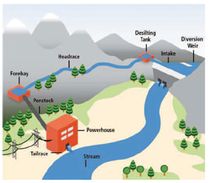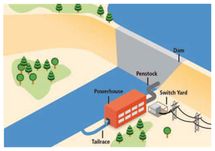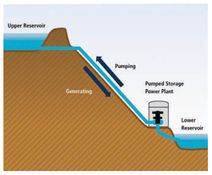By Size
Hydropower installations can be classified by size of power output, although the power output is only an approximate diversion between different classes. There is no international consensus for setting the size threshold between small and large hydropower.For the United Nations Industrial Development Organization (UNIDO) and the European Small Hydropower Association (ESHA) and the International Association for Small Hydro a capacity of up to 10 MW total is becoming the generally accepted norm for small hydropower plants (SHP). In China, it can refer to capacities of up to 25 MW, in India up to 15 MW and in Sweden small means up to 1.5 MW, in Canada 'small' can refer to upper limit capacities of between 20 and 25 MW, and in the United States 'small' can mean 30 MW.
The German Federal Ministry for Environment, Nature Conservation and Nuclear Safety mentioned that a SHP is < 1 MW, everything above is a large hydro electric plant and usually comes along with a large dam. The International Commission on Large Dams (ICOLD) defines a large dam as a dam with a height of 15 m or more from the foundation. If dams are between 5-15 m high and have a reservoir volume of more than 3 million m3, they are also classified as large dams. Using this definition, there are over 45 000 large dams around the world.
Small hydro can be further subdivided into mini, micro and pico:
|
< 1 MW | grid connected | special know how required |
|
< 100 kW | partially grid con. | professional know how required |
|
< 10 kW | island grids | small series units produced locally; professional equipment available |
|
< ~1 kW | single households/clusters | often locally handmade solutions; professional equipment available |
There is no binding definition how Mini hydropower output is to be classified. Rules for communication avoiding misunderstandings: Generally the terms can be used "downwards compatible". Pico- is also Mini- but not visa versa. Specific terms (Pico, Family) should be used only if they are required to indicate specifics. The spectrum needs higher diversification as smaller it becomes as there are certain differences in technique, usage, applicability and the grade of of ability to replicate them.
Comments:
- all installations require "special" knowhow
- there are "over the counter" pico turbines available for "self installation"
- Micro hydro is perhaps the most mature of the modern small-scale energy supply technologies used in developing countries. There are thought to be tens of thousands of plant in the “micro” range operating successfully in China[1], Nepal, Sri Lanka, Pakistan, Vietnam and Peru.
- Historically the term hydropower developed from naming very small units towards nowadays huge dams. Then there where new terms created to separate different clusters. All of them are hydropower. What is considered "mini or "micro" may be defined once and forever ... or not. If there are different opinions on this topic you're welcome to open a discussion group on this.
Comments on the debate “small” versus “large” Hydro Power
Classification according to size has led to concepts such as ‘small hydro’ and ‘large hydro’, based on installed capacity measured in MW as the defining criterion. Defining hydropower by size is somewhat arbitrary, as there are no clear relationships between installed capacity and general properties of hydropower or its impacts. Hydropower comes in manifold project types (see Classification By Facility Type) and is a highly site-specific technology, where each project is a tailor-made outcome for a particular location within a given river basin to meet specific needs for energy and water management services.Large hydropower developments involve large dams and huge water storage reservoirs. They are typically grid connected supplying large grids. Preference for large hydro is on the decline due to the high investment costs, long payback periods and huge environmental impacts (losses of arable land, forced migration, diseases and damage to biodiversity). Many social and environmental impacts are related to the impoundment and existence of a reservoir, and therefore are greater for 'large hydro' plants with reservoir.
Small hydropower stations are typically run-of-the-river. They combine the advantages of hydropower with those of decentralised power generation, without the disadvantages of large scale installations. Advantages include: low distribution costs, no/low environmental costs as with large hydro, low maintenance and local implementation and management. Power generated with small hydro station can be used for agro-processing, local lighting, water pumps and small businesses[1].
The constructions and integration into local environments of Small Hydro Power (SHP) schemes typically takes less time and effort compared to large hydropower plants. For this reason, the deployment of SHPs is increasing in many parts of the world, especially in remote areas where other energy sources are not viable or are not economically attractive.
However, larger facilities will tend to have lower costs on a USD/kW basis due to economies of scale, even if that tendency will only hold on average. Moreover, one large-scale hydropower project of 2,000 MW located in a remote area of one river basin might have fewer negative impacts than the cumulative impacts of four hundred 5 MW hydropower projects in many river basins (see also Negative Environmental Impacts). For that reason, even the cumulative relative environmental and social impacts of large versus small hydropower development remain unclear, and context dependent. General concepts like ‘small’ or ‘large hydro’ are not technically or scientifically rigorous indicators of impacts, economics or characteristics. Hydropower projects cover a continuum in scale, and it may be more useful to evaluate a hydropower project on its sustainability or economic performance, thus setting out more realistic indicators[2].
By Facility Type
Hydropower plants can be classified in three categories according to
operation and type of flow (see figure a-c). a) Run-of-river (RoR),b) storage (reservoir) and
c) pumped storage HPPs
In addition, there is a fourth category (d) called in-stream technology, which is a young and less-developed technology.
Storage HPPs require high dams and big storage areas to be flooded. Such is usually the case in big infrastructure projects including the known environmental impacts. Small and micro hydropower usually avoids those but utilizes water that runs of a river.
Pumped storage HPPs work as energy buffer and do not produce net energy.
a) Run-of-River Hydropower Plant
|
|
|
b) Hydropower Plant with Reservoir
|
c) Pump Storage Hydropower Plant
|
d) In-stream Hydropower Scheme
| Space for a figure |
|
Text and Figures of this article are mainly taken from the Chapter 5 of the IPCC Special Report on Renewable Energy Sources and Climate Change Mitigation (2011). Prepared by Working Group III of the Intergovernmental Panel on Climate Change [O. Edenhofer, R. Pichs-Madruga, Y. Sokona, K. Seyboth, P. Matschoss, S. Kadner, T. Zwickel, P. Eickemeier, G. Hansen, S. Schlömer, C. von Stechow (eds)]. Cambridge University Press, Cambridge, United Kingdom and New York, NY, USA, 1075 pp.













0 comments:
Post a Comment